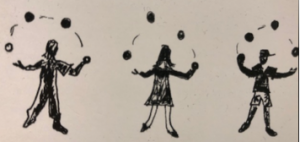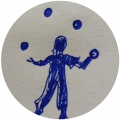Reflection by Alison Taylor, January 23/23
Metaphors are a means of fusing “two separate realms of experience into one illuminating, iconic, encapsulating image”; they are transformative and generative (Turner, 1975, p. 25).1 We adopted the metaphor of the juggler in the ‘Hard Working Student’ study when it began in 2019, although my sense of this metaphor has shifted over time. The definitions of a juggler include ‘one skilled in keeping several objects in motion in the air at the same time by alternately tossing and catching them’ (Merriam Webster) or ‘someone who juggles in order to entertain people’ (Collins). It may also refer to a person who ‘adroitly balances several activities’ (Oxford).
The image is also fun: juggling is said to be a ‘great study break tool and stress reliever, since it keeps the brain active within the guise of a fun diversion from studying for hours on end!’2
Our initial metaphor of juggling (image below) provided a concrete way of thinking about the relationship between school and work for students. We thought it would also appeal to potential student participants in our research study.

As we began speaking to working students over time, it became apparent that the metaphor was generative but needed to be complicated. For one thing, the number and kind of activities and tasks that different students are juggling vary. Further, the perceived risk of ‘dropping balls’ varies. For example, students whose ability to attend university depends on paid work face much greater risk of ‘dropping’ either work or study balls than those who live with parents and are supported financially. Alternately, international students often experience a stronger sense of perceived risk in juggling because of the much higher cost of their studies for families (vis-à-vis domestic students).
In addition, the kinds of things that students juggle varies dramatically. Some students are juggling care work with studies and paid work; some juggle volunteer work and co-curricular activities. Several international students juggle the intersecting work of acculturation, studies, and work. Students with disabilities must also juggle work of seeking institutional accommodations in university and in the workplace. If the “juggler” knows what they’re doing (if they have the rhythm down), juggling looks easy…but it actually requires a great deal of skill.
In terms of paid work, students’ jobs range from serving and retail jobs to working in a start-up to working as a research assistant on campus (among other possibilities). The hours they work range from under 5 to over 20 per week. The items that students juggle and the rate at which they juggle over time change too: in first year, students may focus on school and one club, while in third year, they may be juggling a coop placement, studies, and/or part-time work over the year. Juggling takes practice and one has to build up to manipulating more and more balls.
In short, the complexity of student lives is reflected in the variety of forms of juggling that are apparent. However, while the success of juggling is easy to see (either you juggle balls or you drop balls), it is more difficult to gauge how undergraduate students’ juggling of commitments impacts their lives in the future. And while the benefits of juggling are said to be ‘improved hand-eye coordination, bi-manual dexterity, focused concentration, goal-setting skills, problem solving skills, and delayed gratification,’3 this research problematizes and complicates some of its effects for different students.
Finally, it is helpful to think about juggling as a “complex perceptual motor skill that requires motor competence, memory of ball movement, and temporal-spatial relations embedded in the execution of the pattern” (Lamfromm & Gopher, 2011, p. 1).4 While I began this study with the idea that we needed to look at the impacts of work on studies (a common theme in the literature), I soon realized that what students bring to the juggling act (including their dispositions based on past experiences), their resources (including capacities and competencies), and their responses to the temporal structures of universities and workplaces, impact what they juggle, how they juggle, and how they make sense of their juggling act. The more complex image that introduces this reflection—with shifting faces and multiple objects in motion—reflects some of the shifts in my sense-making.
Another constructive feature of metaphors is that they’re open to different interpretations. We would love to hear from students about your thoughts and experiences of juggling.
Notes
- Turner, V. W. (1974). Dramas, fields, and metaphors: Symbolic action in human society. Cornell University Press.
- See article on The Cognitive Benefits of Juggling: https://jugheads.com/the-cognitive-benefits-of-juggling/
- City of Lakes Waldorf school site; https://www.clws.org/waldorf-education/curriculum/juggling-benefits-students/
- Lammfromm, R., & Gopher, D. (2011). Transfer of skill from a virtual reality trainer to real juggling. BIO Web of Conferences, 1, 54. https://doi.org/10.1051/bioconf/20110100054
Reflection by the ‘animator,’ Robyn Taylor-Neu
When the anthropologist Victor Turner spoke about “root metaphors” that ground larger systems of thought, discourse, and lived practice, he chose his trope wittingly. Metaphors grow by definition, becoming deeper, denser, extending tendrils in different directions. They are like root systems or, in the all-too-trendy Deleuzian parlance, rhizomes.
When I was animating the image of the juggler that you see above, I kept discovering new aspects of the metaphor, new depths and dimensions. Here, I’d like to share just a few of the resulting reflections and consider how a more nuanced understanding of the act of juggling might further illuminate students’ balancing of school, work, and other commitments.
First, juggling is all about rhythm and, more specifically, about the coordination of different rhythms. The juggler’s hands move in defined loops, keeping a consistent pace, while the objects arc through the air. Juggling three objects involves a different rhythm than juggling five, for example, because each object is aloft for longer, tracing a steeper parabola. The juggler must gauge how much energy is needed to suspend each object for the right amount of time–when the object drops back to earth, the juggler must have a free hand to scoop it up and send it airborne again. Juggling commitments likewise involves the coordination of different rhythms and different trajectories.
Second, while the movement of each piece is relatively simple, putting it all together is more complicated than it looks (and again, this has to do with rhythm and coordination). Anyone can move their hands like a juggler–the motion itself is not complex–and the path of each object is more-or-less predictable. But to keep several objects in orbit requires coordination and finesse. Similarly, neither attending classes nor showing up for work shifts is especially hard if that’s all you’re doing. The difficulty lies in doing both (and more) simultaneously.
Third, the juggler must adjust to accommodate different objects. One does not palm a mug the same way one grips a notebook, cradles a beaker, or grasps a pencil–so the juggler must know exactly what they are catching and when. For working students who are juggling a variety of commitments, this means adopting distinct positions, attire, and attitudes according to their shifting roles and the demands of different situations. These are just a few observations that occurred to me in the process of working on the juggler animation; I’d be curious to hear whether they resonate with the students involved in this study.

